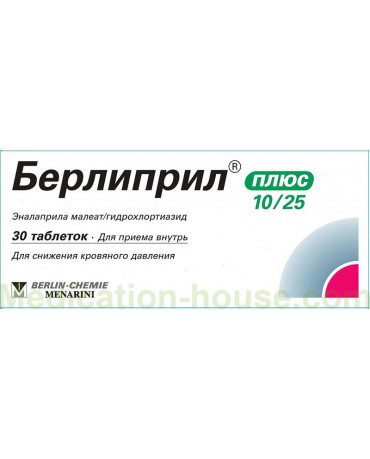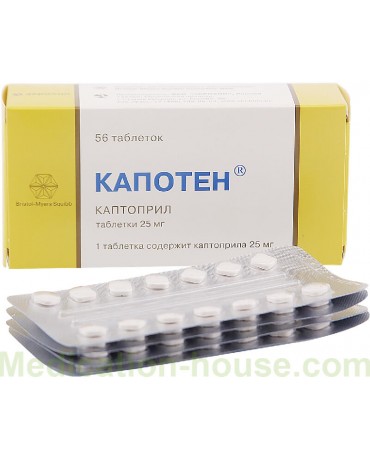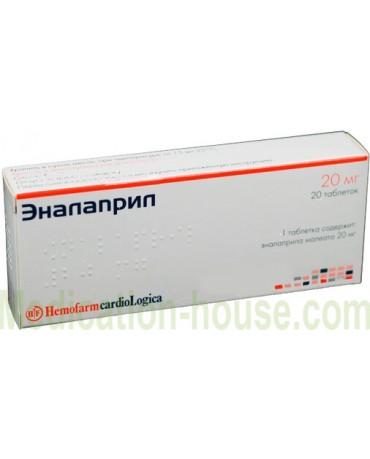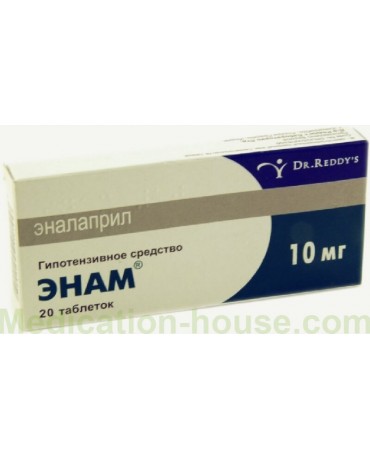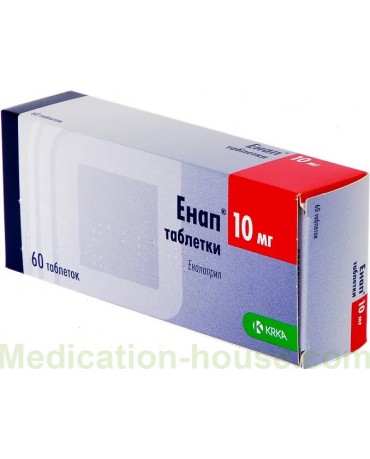Berlipril user manual
To buy Berlipril just add it to your shopping cart
Berlipril is a drug that regulates blood pressure levels.
Release form and composition
Berlipril is available in tablets: round, slightly convex on both sides, with beveled edges, on one side there is a risk (in blisters of 10 pcs., 2, 3, 5 or 10 blisters in a cardboard box).
The main active ingredient: enalapril maleate, the content of which is in:
Berlipril 5 - 5 mg (the color of the tablets is white or almost white);
Berlipril 10 - 10 mg (the color of the tablets is light brown, white blotches are acceptable);
Berlipril 20 - 20 mg (the color of the tablets is pale pink, inclusions of white and dark pink are acceptable).
As auxiliary substances used: light magnesium carbonate, magnesium stearate, lactose monohydrate, sodium carboxymethyl starch, gelatin; Berlipril 10 and 20 additionally include iron oxide brown (E172).
Indications for use
Chronic heart failure (combination therapy);
Arterial hypertension (including renovascular);
Asymptomatic dysfunction of the left ventricle as a result of myocardial infarction (combination therapy).
Contraindications
Angioneurotic edema, which develops as a result of taking ACE (in history);
Porphyria;
Pregnancy, as well as the period of breastfeeding;
Sensitivity to enalapril and other ACE inhibitors;
Children and adolescents up to 18 years old.
The drug is used with caution in the presence of the following diseases / conditions:
Primary hyperaldosteronism;
Bilateral renal artery stenosis;
Stenosis of an artery of a solitary kidney;
Aortic stenosis;
Condition after kidney transplant;
Mitral stenosis for hemodynamic problems;
Idiopathic hypertrophic subaortic stenosis;
Connective tissue diseases;
Coronary heart disease;
Hyperkalemia;
Cerebrovascular disease;
Diabetes;
Liver failure;
Renal failure with proteinuria more than 1 g per day.
Doctor's supervision is necessary during Berlipril therapy simultaneously with saluretics and immunosuppressants, as well as if the patient is over 65 years old.
Method of administration and dosage
Taking Berlipril 5, 10, 20 does not depend on the time of the meal.
For monotherapy in the treatment of arterial hypertension, an initial dose of 5 mg is prescribed once a day. If no clinical effect is observed, the dose is increased by 5 mg after 1-2 weeks.
After the first intake of the drug, the patient is under medical supervision until the pressure stabilizes (two to three hours).
If it is necessary to increase the dose (provided that Berlipril is well tolerated), it is increased to 40 mg per day (in 1-2 doses). After 2-3 weeks, the patient is transferred to a maintenance dosage of Berlipril - 10-40 mg per day (in 1 or 2 doses).
For use in complex therapy, the following dosage is recommended:
Moderate hypertension: 10 mg / day on average, the maximum allowable dose is 40 mg / day;
Renovascular hypertension: initial dose 2.5-5 mg / day, maximum - 20 mg / day;
Chronic heart failure: an initial dose of 2.5 mg (taken once), then the dose is increased every three to four days by 2.5-5 mg, observing clinical reactions (depending on the value of blood pressure, the maximum allowable dose is determined, but not more 40 mg per day in 1 or 2 divided doses). If the patient has a low systolic pressure (up to 110 mm Hg), then treatment begins with 1.25 mg, the determination of the required maintenance dosage is carried out in the next 2-4 weeks (on average, from 5 to 20 mg per day in 1 or 2 receptions);
Dysfunction of the left ventricle, asymptomatic: at the beginning of treatment, the drug is prescribed 2 times a day, 2.5 mg. Further dosage is selected, taking into account the patient's tolerance to the drug, up to a maximum of 20 mg in 2 divided doses.
The drug is prescribed to elderly patients in an initial dose of no more than 1.25 mg.
When taking the drug, you should not exceed the dose prescribed by your doctor. In case of an overdose, blood pressure is clearly reduced, and against this background, stroke, myocardial infarction, stupor, thromboembolism, convulsions are possible. For treatment, the patient should be fixed in a horizontal position, his stomach should be flushed, then sorbents, infusion therapy, administration of angiotensin II, hemodialysis should be prescribed.
Side effects
The use of Berlipril can cause side reactions from different body systems:
Cardiovascular system: hypotension, orthostatic collapse, angina pectoris, heart attack, chest pain, arrhythmia, palpitations, fainting;
Central and peripheral nervous system: insomnia, anxiety, headache, weakness, dizziness, confusion, drowsiness, fatigue; rarely, when taking large doses - depression, paresthesia, nervousness;
Sense organs: impaired vision, hearing, vestibular disorders, tinnitus;
Digestive system: anorexia, vomiting, dry mouth, diarrhea, nausea; rarely - pancreatitis, intestinal obstruction, hepatitis, abdominal pain, jaundice, dysfunction of the biliary tract, liver;
Respiratory system: pharyngitis, shortness of breath, dry unproductive cough, bronchospasm, interstitial pneumonitis, rhinorrhea;
Urinary system: proteinuria, impaired renal function.
In addition, the use of the drug can lead to alopecia, decreased libido, hot flashes, allergic reactions of varying degrees of manifestation.
Special instructions
During treatment, blood pressure (blood pressure), levels of hemoglobin, potassium, urea, transaminases, creatinine should be monitored.
It is important to inform your surgeon or anesthesiologist before surgery is started.
Driving vehicles or managing complex mechanisms during the period of therapy is undesirable.
Terms and conditions of storage
Keep out of reach of children. Storage temperature up to 25 ° C.
The shelf life is 3 years.
Terms of sell
You can buy Berlipril without a prescription.



